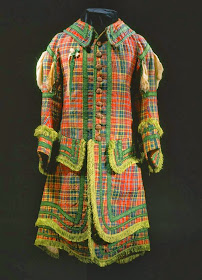If it isn’t obvious by now, I am intrigued with Scottish
History, but I hope to use that interest as a springboard for more expansive
thoughts.
History is about particulars,
but equally it is about the expansion of the general from the particular. A
case in point is an object in the collection of the National Museum of
Scotland.
While searching for
information on the early Jacobite rebellions I came across an archer’s coat. It
is a tartan coat of the Royal Company of Archers and according to the museum
archives if is from circa 1750. At first glance that would be as wrong as
anything I know.
The style of the coat
is at least 75 years older than that, and in fact I have seen this same coat on
the Internet dated as being from 1715, which still seems only slightly less
jarring. So what is it, 1715 or 1750 and how long were the archers and their
tailors living in the hills? The search was on for information about this coat,
which led to the family portrait illustrated here.
The
painting appeared in several online articles, but I couldn’t find an
attribution. Finally one posting
attributed it to Du Pan, who it developed was Barthélemy Du Pan and the subjects were the children of
Frederick, Prince of Wales. The figure in
the tartan archery uniform is the future George III. His outfit is that of the Royal Company of
Archers, who are the ceremonial bodyguards of the sovereign in Scotland. Formed
as a society of archers in the 1670s they obtained a charter from Queen Anne in
1704 and letters patent as a royal company in 1713. The uniform of the company was created at or
about this time and is a “plainer” version of the uniform worn by the young
George. This uniform was the standard though his time and then lapsed until 1789
when a more contemporary version was created. Preparing for the visit of George
IV in 1822, a uniform was created using black watch tartan for the trews and
short jacket. This is a synopsis of information
that comes from an article concerning the Archers on the web by Peter Eslea
MacDonald and is well worth a full read. The author goes into detail about the
tartan and the history of the company. He says it much better than I.
 |
| Prince George in Archer's Attire |
What intrigues me is that without the supporting evidence of
the Archer’s use of historical costume, as a uniform, the dating would look
wrong.
The fact that the uniform was
unchanged for decades and was stylistically dated when conceived around 1713
creates an anachronism that can confuse the modern eye. MacDonald creates a
visual timeline that places this particular anachronism within a forty-year
span.
How often does this happen without
our awareness? Were items of clothing created for a specific purpose that were
recognized at the time as being anachronistic?
In an age that saw itself as public theatre are we at a risk of dating
too specifically or rather too knowingly. I’m not looking to overturn the cart,
rather are there groups or events which create their own timeframe outside of
the normal flow for a specific reason, that goes as of yet undocumented?
Along those lines and back to the painting for a moment, I
was somewhat troubled that the future George III, a Hanoverian, was posing in a
tartan archer’s outfit so close to the aftermath of the Battle of Culloden. By
1747 the use of tartan was proscribed for most uses and in common parlance it
was outright banned, so why record that image?
After all, if time is everything in history, George is out of cycle. In
its day it was a popular print, but I was able to find the painting in the Royal
Collection. Luckily for me the curator
answered my nagging thought and I think it is worth quoting the section in full,
“The inclusion of tartan (worn by
Prince George) in a painting executed within months of the Battle of Culloden
excited comment even at the time. In fact this is the uniform of the Royal
Company of Archers, which had been fixed as early as 1713 and included the
Stuart tartan; like all British regimental tartan this escaped the ban on
Scottish national dress which followed the Rebellion of 1745. Indeed it is probably
that this painting is a part of the process of assimilating Scottish identity
as something manly and romantic, rather than threatening and rebellious.”
Odd isn’t it that an archaically styled uniform of a
vanquished group was seen by the victor to offer
the promise of reconciliation? This is why I often prefer history to fiction. Here is the image of the future George III,
the farmer king, in a stylistically archaic tartan uniform 70 odd years before
his more sartorially recognized son, George IV, wore tartan so famously in 1822.
George IV and Sir Walter Scott, the marshaling force behind the 1822 visit,
have been criticized for their unbridled creativity and reinvention of costume.
Maybe they did, but they were hardly new to the block.
Jeffrey Hopper is an author, editor and the Manager of the Warner House, in Portsmouth, NH.





















